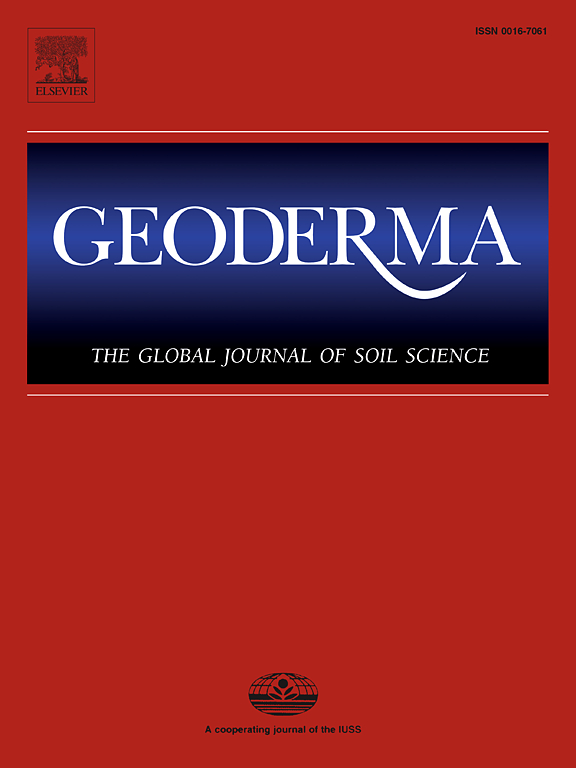硝化抑制剂通过潜在地靶向亚硝化螺旋体簇3a和反硝化菌来减少mollisol的N2O排放
IF 5.6
1区 农林科学
Q1 SOIL SCIENCE
引用次数: 0
摘要
硝化抑制剂(NIs)被广泛用于减少农业土壤中的一氧化二氮(N2O)排放。然而,由于不同的环境条件和仍有争议的抑制机制,特别是负责N2O生产的硝化和反硝化菌的反应,其效率高度不确定。在这里,我们进行了微观培养,研究了在不同水分水平(60%和90%的水填充孔隙空间,WFPS)下,三种NIs (DCD, DMPP和nitrapyrin)对栽培Mollisols N2O排放的比较效果。测定了土壤硝化速率、n2o相关基因丰度和氨氧化细菌(AOB)群落组成。结果表明,在不同土壤湿度条件下,所有NIs均能有效抑制硝化作用,其中DCD和DMPP的抑制作用高于硝基吡啶。有趣的是,与60% WFPS相比,90% WFPS下N2O排放量的减少幅度更大(39.0 - 47.6% vs 26.8 - 31.9%)。NIs选择性地降低了AOB中amoA基因的丰度,而不是氨氧化古菌。最丰富的AOB (>;90%)属亚硝基螺旋体。RDA分析表明,AOB亚硝化螺旋体簇3a与N2O排放的关系最大,其丰度随NI的变化而显著降低。此外,非目标反硝化基因(nirS和nirK)被抑制,特别是在高湿度水平下,这进一步有助于减少N2O排放。总的来说,我们的研究结果强调了环境条件、AOB的关键物种以及反硝化菌的非靶向效应对NIs效果的重要作用。此外,这些结果表明,在极端降雨事件加剧的气候变化背景下,NIs是减少N2O排放的有效肥料管理选择,DCD和DMPP在栽培Mollisols农业系统中具有良好的前景。本文章由计算机程序翻译,如有差异,请以英文原文为准。
Nitrification inhibitors reduce N2O emissions from Mollisols by potentially targeting Nitrosospira cluster 3a and denitrifiers
Nitrification inhibitors (NIs) are widely used to mitigate nitrous oxide (N2O) emissions from agricultural soils. However, its efficiency is highly uncertain owing to varying environmental conditions and still-debated inhibition mechanisms, especially the responses of the nitrifiers and denitrifiers responsible for N2O production. Here, we conducted microcosm incubations to investigate the comparative effectiveness of three NIs (DCD, DMPP, and nitrapyrin) on N2O emissions from cultivated Mollisols under contrasting moisture levels (60 % and 90 % water-filled pore space, WFPS). The soil nitrification rate, N2O-related gene abundance, and community composition of ammonia-oxidizing bacteria (AOB) were determined. The results showed that all NIs effectively inhibited nitrification, with DCD and DMPP having higher efficacy than nitrapyrin, regardless of soil moisture conditions. Interestingly, a greater decrease in N2O emissions was observed under 90 % WFPS than 60 % WFPS (39.0–47.6 % vs. 26.8–31.9 %). NIs selectively decreased the amoA gene abundance in AOB rather than in ammonia-oxidizing archaea. The most abundant AOB (> 90 %) belonged to Nitrosospira. RDA analysis revealed that the AOB Nitrosospira cluster 3a had the greatest relationship with N2O emissions, and its abundance was significantly decreased with NI amendments. Moreover, non-target denitrifying genes (nirS and nirK) were suppressed, particularly at high moisture levels, which further contributed to reduced N2O emissions. Overall, our findings highlight the significant role of environmental conditions, keystone species of AOB, and non-targeted effects on denitrifiers on the efficacy of NIs. Additionally, these results imply that NIs are a potent option for fertilizer management to mitigate N2O emissions and that DCD and DMPP have promising prospects for the cultivated Mollisols agro-system under climate change with intensifying extreme rainfall events.
求助全文
通过发布文献求助,成功后即可免费获取论文全文。
去求助
来源期刊

Geoderma
农林科学-土壤科学
CiteScore
11.80
自引率
6.60%
发文量
597
审稿时长
58 days
期刊介绍:
Geoderma - the global journal of soil science - welcomes authors, readers and soil research from all parts of the world, encourages worldwide soil studies, and embraces all aspects of soil science and its associated pedagogy. The journal particularly welcomes interdisciplinary work focusing on dynamic soil processes and functions across space and time.
 求助内容:
求助内容: 应助结果提醒方式:
应助结果提醒方式:


